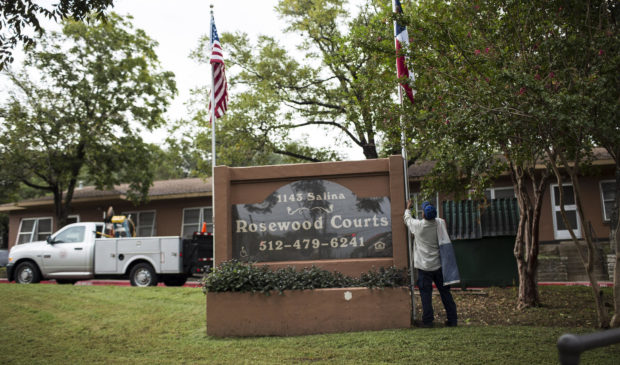Rosewood Courts renovation gets initial approval from landmark commission
Wednesday, February 28, 2018 by
Syeda Hasan The Historic Landmark Commission is paving the way for a major renovation of Rosewood Courts. The public housing project in East Austin was the first in the country built for black residents.
The commission previously recommended zoning the entire site as historic. On Monday, the commission changed that recommendation to apply to just eight buildings, allowing the Housing Authority of the City of Austin to renovate the other 17 buildings on the site.
Historic Preservation Officer Steve Sadowsky told commissioners that would allow for hundreds of new affordable housing units.
“This was the result of a long period of negotiations,” he said, “and staff is fully supportive of the compromise that was reached between all parties.”
City Council will have the final say on whether the plan gets implemented, but recommendations from the landmark commission help inform Council’s decisions.
Rosewood Courts’ history has shaped a long-standing debate over what to do with the property.
Several residents spoke Monday about poor living conditions, including a lack of reliable air conditioning and wheelchair accessibility. Some compared their apartments to jail cells.
Sylvia Blanco, executive vice president of the housing authority, said renovations were long overdue for the public housing property, which has “reached the end of its life cycle.”
“What was originally created to offer a better quality of life for families has become obsolete and in desperate need of revitalization,” she said.

Children wave from a slide in the play area of Rosewood Courts in this photo circa 1943. The public housing project was the first in the country built for black residents. Photo courtesy of the Housing Authority of the City of Austin.
Some opponents of the plan maintained that the entire property should be preserved. Activist Fred McGhee, one of the loudest voices in the fight for preservation, said the case is part of a larger trend of the city failing to recognize historic sites in East Austin.
“There is a massive inequity between west of I-35 and east of I-35,” he said. “One of the first questions about equity is this: How much taxpayer value is going to the people in West Austin … versus East Austin?”
This story was produced as part of the Austin Monitor’s reporting partnership with KUT. Top photo by Martin do Nascimento/KUT.
The Austin Monitor’s work is made possible by donations from the community. Though our reporting covers donors from time to time, we are careful to keep business and editorial efforts separate while maintaining transparency. A complete list of donors is available here, and our code of ethics is explained here.
You're a community leader
And we’re honored you look to us for serious, in-depth news. You know a strong community needs local and dedicated watchdog reporting. We’re here for you and that won’t change. Now will you take the powerful next step and support our nonprofit news organization?









